Teaching Reform in C Programming Course from the Perspective of Sustainable Development: Construction and 9-Year Practice of “Three Classrooms–Four Integrations–Five Combinations” Teaching Model
Abstract
:1. Introduction
1.1. Teaching Reform of Course Informatization
1.2. Teaching Reform Based on OBE
1.3. Teaching Reform Based on the Requirements of the “Golden Course”
1.4. Teaching Reform Based on Curriculum Ideology and Politics
2. Basic Information about the C Programming Course
2.1. Main Content
2.2. Main Objectives
- (1)
- To enable students to master the basic syntax of the C language, the basic flow of programming, the basic ideas of typical algorithms, the basic structure of programs, and the basic methods of program debugging, which are five types of basic knowledge, and to have a good programming style.
- (2)
- Faced with complex engineering problems [25] in computing, students can select appropriate data structures to determine algorithms, implement them using C, and develop logical thinking, analytical problem-solving skills, and programming practice abilities.
- (3)
- To equip students with the four qualities of reading and writing programs, team spirit, innovative applications, and lifelong learning.
2.3. The Urgency of Course Teaching Reform
3. Analysis of Teaching Pain Points and Countermeasures
3.1. Teaching Pain Points
- (1)
- Teaching philosophy: The C programming course has many knowledge points, and teaching modes using traditional teaching philosophies are not sufficiently personalized or innovative to support the cultivation of students’ ability to solve complex engineering problems. There is no overall conception of course construction, and course teaching is still teacher-centered.
- (2)
- Independent learning: Students are mostly passive learners and lack effective teaching resources to support independent learning. There is also a lack of effective online platforms to facilitate knowledge review, practice, training, and consolidation.
- (3)
- Teaching methods: It is common to see “spoon-fed” information and silence in the classroom without the use of appropriate methods to enhance students’ computational thinking abilities, programming practice, and innovation.
- (4)
- Course evaluation: Course evaluation only uses examination results and usual grades to measure performance. Moreover, examinations are mostly written by the lecturers who taught the course without implementing the separation of teaching and examination, which lacks comparability and cannot effectively assess students’ knowledge mastery and programming practice ability.
- (5)
- Ideological politics in the curriculum: Ideological politics in the curriculum means that the ideological and political elements of education, including theoretical knowledge, values, and the spiritual pursuit of ideological and political education, are integrated into the curriculum to influence students’ ideologies and behavior in a subtle way. There is currently a lack of course application cases and the design of an organic combination of political elements. Achieving the implementation of ideological politics into the curriculum and the implementation of the goal of moral education are very difficult.
3.2. Countermeasure Analysis
4. Design of Teaching Reform and Construction of the Teaching Model
4.1. Design of Teaching Reform
- (1)
- Change the teaching philosophy to form a conceptual shift conducive to ability training and moral character shaping.
- (2)
- Enrich teaching resources and provide quality resources conducive to open sharing in course teaching.
- (3)
- Reconstructing the teaching environment and forming a teaching ecology conducive to collaborative integration inside and outside the classroom.
- (4)
- Reshaping the course content to form ability modules conducive to the progressive implementation of project-based teaching.
- (5)
- Transforming the teaching process and developing collaborative teaching strategies to facilitate the implementation of the teaching model.
- (6)
- Innovative teaching methods to achieve a seamless transition conducive to the collaborative promotion of ability training and moral character shaping.
- (7)
- Reform course evaluation and realize diversified course performance evaluation conducive to course achievement degree analysis.
- (8)
- Building the ecology of the curriculum with ideological politics and forming an ecology of moral education that is conducive to implementing the goal of educating people about morality.
4.2. Construction of Teaching Model
5. Teaching Reform Features and Innovations
5.1. Teaching Reform Features
- (1)
- This course teaching reform focuses on a holistic approach. With the synergy formed by the eight dimensions of systematic reform, a new ecology of education has been built to meet the needs of “golden course” construction, engineering education professional accreditations, and ideological politics in the curriculum in the new era.
- (2)
- A course co-examination mechanism has been constructed with provincial universities, creating a new model for course examinations. Post-exam analyses and summaries were made promptly, and methods for teaching the course and ways to improve teaching quality were explored collaboratively through seminars, opening up a new way for the course to be built jointly by multiple schools.
- (3)
- The classroom teaching, practice, and independent learning system have been improved. Deepening students’ understanding and awareness of course knowledge, fully mobilizing their enthusiasm and initiative, and cultivating their innovative thinking and practical ability have achieved remarkable results.
5.2. Teaching Reform Innovations
- (1)
- The teaching model of “three classrooms–four integrations–five combinations” has been established. In the classroom, teachers provide lectures on key and difficult knowledge, and the students complete the course pre-study and practice independently before and after class based on the online platform resources. The three-dimensional classes and open teaching resources have achieved better results, enabling students to grasp knowledge, make break throughs in key and difficult knowledge, and realize the synergy of ability training, the ideological politics in the curriculum, and moral character shaping.
- (2)
- The effective four-in-one teaching strategy of “understanding during learning, strengthening during exercises, consolidating during practice, and innovating during breakthrough” is used to implement the teaching model. The course teaching highlights the students’ main role and cultivates their innovative spirit, teamwork, and sense of social responsibility.
6. Course Evaluation and Reform Effect
6.1. Evaluation of the Implementation Process
6.2. Evaluation of the Effectiveness of the Course Teaching Reform
6.2.1. Significant Improvement in Students’ Exam Results
6.2.2. High Achievement of the Engineering Education Professional Certification Graduation Requirements Supported by the Course
6.3. Achievements and Application of the Course
6.3.1. The Teachers’ Ability to Build and Reform the Course Has Improved Significantly
6.3.2. Students’ Sense of Acquisition Is Increased, and Their Practical Ability, Innovation, and Moral Character Are Improved
6.3.3. The Experience of Replicable and Sustainable Course Teaching Reform Has Generated a Strong Response
7. Conclusions
- (1)
- The teaching model created by the teaching reform has led to a change in the teaching philosophy of teachers from “teacher-centered” to “student-centered”, which has facilitated the improvement of the teaching methods and the course strategies. The achievement degree of the course effectively supports the graduation requirements for engineering education accreditations. Since 2013, the course reform has successfully made the C Programming course a high-quality course at Huaihua university and a first-class undergraduate course in Hunan Province.
- (2)
- The teaching mode has helped students to enhance their independent learning ability and to cultivate their practical ability and the ability to solve complex engineering problems. It has deepened students’ understanding of the course knowledge and has mobilized their motivation and initiative.
- (3)
- This teaching model has cultivated innovative thinking and has enhanced students’ creative abilities, helping our students to achieve fruitful results in winning programming competitions, publishing academic papers, applying for student innovation projects, applying for software copyrights, applying for patents, and participating in local project development services.
- (4)
- The teaching mode focuses on fostering virtue through education, which is conducive to cultivating students to have a correct outlook on life and values and cultivating a group of students with good character and a strong sense of social responsibility.
- (5)
- The teaching mode has achieved a good promotion effect. It has been promoted and applied to 12 engineering courses in our university, with six courses being recognized as first-class undergraduate courses at the provincial level, and four being recognized at the university level.
Author Contributions
Funding
Institutional Review Board Statement
Informed Consent Statement
Data Availability Statement
Acknowledgments
Conflicts of Interest
References
- Patil, A.; Codner, G. Accreditation of Engineering Education: Review, Observations and Proposal for Global Accreditation. Eur. J. Eng. Educ. 2007, 32, 639–651. [Google Scholar] [CrossRef]
- Wu, Y. Building China’s “Golden Course”. China Univ. Teach. 2018, 2018, 4–9. (In Chinese) [Google Scholar] [CrossRef]
- Zheng, P.; Wang, X.; Li, J. Exploration and Practice of Curriculum Ideological and Political Construction Reform—Take “Information Security” Course as an Example. ASP Trans. Comput. 2021, 1, 1–5. [Google Scholar] [CrossRef]
- Nikolenko, K.; Dovzhuk, V.; Voropayeva, T.; Boiko, S.; Honcharuk, O. Educational Activities in the Context of the Realities of the Information Society: Problems, Pro-Spects. Wisdom 2022, 22, 138–151. [Google Scholar] [CrossRef]
- Ren, Y. Stepping into the New Age of Chinese Education Informatization: Interpretation of Education Informatization 2.0 Action Plan (1). e-Educ. Res. 2018, 39, 27–28+60. (In Chinese) [Google Scholar] [CrossRef]
- Fu, X.; Shimada, A.; Ogata, H.; Taniguchi, Y.; Suehiro, D. Real-Time Learning Analytics for C Programming Language Courses. In Proceedings of the Seventh International Learning Analytics & Knowledge Conference, Vancouver, BC, Canada, 13–17 March 2017; pp. 280–288. [Google Scholar] [CrossRef]
- Zheng, B.; Deng, P. Exploring the Practical Teaching Plan of C Language Programming. In Proceedings of the 2018 International Conference on Education, Psychology, and Management Science (ICEPMS 2018), Shanghai, China, 13–14 October 2018; pp. 867–871. [Google Scholar] [CrossRef]
- Yu, F.-L.T. Outcomes-Based Education. Int. J. Educ. Reform 2016, 25, 319–333. [Google Scholar] [CrossRef]
- Cai, M. Research on Teaching Reform of C Language Course under the Engineering Education Certification. Open J. Soc. Sci. 2022, 10, 120–126. [Google Scholar] [CrossRef]
- Fan, J.; Sun, Q.; Yang, R.; Wang, J.; Hu, C. Project-Driven Teaching Reform and Construction Based on OBE Concept—Taking Teaching Practice of “C Language Programming” for Example. Creat. Educ. Stud. 2021, 9, 1723–1727. [Google Scholar] [CrossRef]
- Liu, J.; Zhao, Y.; Liu, J. Teaching Reform and Exploration of “C Programming” Course Based on OBE Concept. Theory Pract. Educ. 2022, 42, 61–63. (In Chinese) [Google Scholar]
- Li, Y.; Niu, J.; Zhang, J.; Hao, R. Study of Engineering-Oriented Teaching Method in C Programming Course Based on Emerging Engineering Education. In Proceedings of the 2019 IEEE Frontiers in Education Conference (FIE), Covington, KY, USA, 16–19 October 2019; Volume 2019, pp. 1–7. [Google Scholar] [CrossRef]
- Zhang, C.; Zhu, Y.; Wang, C.; Luo, Y.; Li, C. Blended Teaching Based on Multiple Teaching and Learning Platforms: A Case Study of Programming Course. In Proceedings of the 2021 10th International Conference on Educational and Information Technology (ICEIT), Chengdu, China, 18–20 January 2021; pp. 19–23. [Google Scholar] [CrossRef]
- Demaidi, M.N.; Qamhieh, M.; Afeefi, A. Applying Blended Learning in Programming Courses. IEEE Access 2019, 7, 156824–156833. [Google Scholar] [CrossRef]
- Alammary, A. Blended Learning Models for Introductory Programming Courses: A Systematic Review. PLoS ONE 2019, 14, e0221765. [Google Scholar] [CrossRef] [PubMed] [Green Version]
- Zhao, W. Mixed Teaching Pattern Exploration Integrating Online and Offline Platforms Oriented to Continuous Improvement for Engineering Accreditation: Practice in computer programming course as a presentation case. In Proceedings of the 13th International Conference on Education Technology and Computers (ICETC 2021), Wuhan, China, 22–25 October 2021; pp. 123–128. [Google Scholar] [CrossRef]
- Ma, L.; Zhang, Z.; Zhang, N. Study on the Mixed Teaching Mode of the Program Language Courses in the New Situation. J. Phys. Conf. Ser. 2020, 1544, 012123. [Google Scholar] [CrossRef]
- Li, X.; Gu, C. Teaching reform of programming basic course based on SPOC blended teaching method. In Proceedings of the 2020 15th International Conference on Computer Science & Education (ICCSE), Delft, The Netherlands, 18–22 August 2020; pp. 411–415. [Google Scholar] [CrossRef]
- Wang, L.; Han, X.; Gao, Y. Research of Construction and Practice of Blended “Golden Course” Teaching Based on C language programming. In Proceedings of the 2021 2nd International Conference on Big Data and Informatization Education (ICBDIE), Hangzhou, China, 2–4 April 2021; pp. 587–590. [Google Scholar] [CrossRef]
- Yuan, H. Reform of Online/Offline Mixed Teaching Mode Based on MosoTeach. In Proceedings of the 2021 International Conference on Big Data Engineering and Education (BDEE), Guiyang, China, 12–14 August 2021; pp. 96–100. [Google Scholar] [CrossRef]
- Li, C. Problems and Countermeasures of Ideological and Political Construction of University Curriculum Under the Background of the Implementation of the Guidelines for Ideological and Political Construction of Curriculum in Colleges and Universities. In Guanghua Law Review; Southwestern University of Finance and Economics: Chengdu, China, 2020; pp. 135–142. (In Chinese) [Google Scholar]
- Li, H.; Zhang, M.; Li, C. Research on the Entry Point of Curriculum Ideology and Politics in the Teaching of Computer Programming. In Proceedings of the 2021 2nd International Conference on Education, Knowledge and Information Management (ICEKIM), Xiamen, China, 29–31 January 2021; pp. 286–289. [Google Scholar] [CrossRef]
- Shi, J. Curriculum Ideological and Political Construction Based on Blended Teaching Model—Take the Preparatory Course of C Language Programming as an Example. Theory Pract. Innov. Entrep. 2021, 4, 43–45. (In Chinese) [Google Scholar]
- Desha, C.; Rowe, D.; Hargreaves, D. A Review of Progress and Opportunities to Foster Development of Sustainability-Related Competencies in Engineering Education. Australas. J. Eng. Educ. 2019, 24, 61–73. [Google Scholar] [CrossRef]
- Xu, X.; Xu, F. Development of Ability to Solve Complex Engineering Problems for Engineering College Students. Bull. Surv. Mapp. 2020, 142–145. [Google Scholar] [CrossRef]
- Schönwetter, D.J. A Future-Ready Teaching Philosophy: Opportunities to Reflect, Re-Value and Re-Frame a Teaching Philosophy. ETH Learn. Teach. J. 2020, 2, 437–443. [Google Scholar]
- Bowne, M. Developing a Teaching Philosophy. J. Eff. Teach. 2017, 17, 59–63. [Google Scholar]
- Sobaih, A.E.E.; Salem, A.E.; Hasanein, A.M.; Elnasr, A.E.A. Responses to COVID-19 in Higher Education: Students’ Learning Experience Using Microsoft Teams versus Social Network Sites. Sustainability 2021, 13, 10036. [Google Scholar] [CrossRef]
- Zhang, J.; Chen, Z.; Duan, C.; He, X. Reshaping the Teaching Ecology with the Construction of Informationalized Teaching Mode. In Proceedings of the 2019 4th International Conference on Distance Education and Learning, Shanghai, China, 24–27 May 2019; pp. 184–188. [Google Scholar] [CrossRef]
- Li, L.; Reconstruction, E.O. Optimization and Reconstruction of University Classroom Ecology under the Threshold of “Internet+”. Adult High. Educ. 2022, 4, 60–69. [Google Scholar] [CrossRef]
- Zhang, X.; Ma, Y.; Jiang, Z.; Chandrasekaran, S.; Wang, Y.; Fonkoua Fofou, R. Application of Design-Based Learning and Outcome-Based Education in Basic Industrial Engineering Teaching: A New Teaching Method. Sustainability 2021, 13, 2632. [Google Scholar] [CrossRef]
- Han, F. The Relations between Teaching Strategies, Students’ Engagement in Learning, and Teachers’ Self-Concept. Sustainability 2021, 13, 5020. [Google Scholar] [CrossRef]
- Safapour, E.; Kermanshachi, S.; Taneja, P. A Review of Nontraditional Teaching Methods: Flipped Classroom, Gamification, Case Study, Self-Learning, and Social Media. Educ. Sci. 2019, 9, 273. [Google Scholar] [CrossRef] [Green Version]
- Yang, P.; Lai, S.; Guan, H.; Wang, J. Teaching Reform and Practice Using the Concept of Outcome-Based Education. Int. J. Emerg. Technol. Learn. 2022, 17, 68–82. [Google Scholar] [CrossRef]
- Zou, Q. Exploring the Education Reform of Architectural Drawing and Drafting Under the Background of Curriculum Ideology and Politics. J. Contemp. Educ. Res. 2022, 6, 40–48. [Google Scholar] [CrossRef]
- Kumar, D.; Jaipurkar, R.; Shekhar, A.; Sikri, G.; Srinivas, V. Item Analysis of Multiple Choice Questions: A Quality Assurance Test for an Assessment Tool. Med. J. Armed Forces India 2021, 77, S85–S89. [Google Scholar] [CrossRef]
- Tangney, J.P.; Stuewig, J.; Mashek, D.J. Moral Emotions and Moral Behavior. Annu. Rev. Psychol. 2007, 58, 345–372. [Google Scholar] [CrossRef] [Green Version]
- Petousi, V.; Sifaki, E. Contextualising Harm in the Framework of Research Misconduct. Findings from Discourse Analysis of Scientific Publications. Int. J. Sustain. Dev. 2020, 23, 149. [Google Scholar] [CrossRef]
- Tang, Z. Big Data Analysis and Modeling of Higher Education Reform Based on Cloud Computing Technology. Secur. Commun. Netw. 2022, 2022, 4926636. [Google Scholar] [CrossRef]
- Khan, M.A.; Khojah, M.; Vivek. Artificial Intelligence and Big Data: The Advent of New Pedagogy in the Adaptive E-Learning System in the Higher Educational Institutions of Saudi Arabia. Educ. Res. Int. 2022, 2022, 1263555. [Google Scholar] [CrossRef]
- Hao, Y.; Leng, C.; Zheng, H.; Zhang, H. Research on Online Learning Behavior Analysis Based on Big Data Architecture. In Proceedings of the 2021 2nd International Conference on Computers, Information Processing and Advanced Education (CIPAE 2021), Ottawa, ON, Canada, 25–27 May 2021; pp. 519–523. [Google Scholar] [CrossRef]
- Bo, Y.; Wang, C.; Li, L.; Lu, X. Student Ability Portrait Construction Research Based on Big Data. In Proceedings of the 2022 International Conference on Big Data, Information and Computer Network (BDICN), Sanya, China, 20–22 January 2022; pp. 156–160. [Google Scholar] [CrossRef]
- Bagunaid, W.; Chilamkurti, N.; Veeraraghavan, P. AISAR: Artificial Intelligence-Based Student Assessment and Recommendation System for E-Learning in Big Data. Sustainability 2022, 14, 551. [Google Scholar] [CrossRef]
- Yang, C.C.Y.; Chen, I.Y.L.; Ogata, H. Toward Precision Education: Educational Data Mining and Learning Analytics for Identifying Students’ Learning Patterns with Ebook Systems. Educ. Technol. Soc. 2021, 24, 152–163. [Google Scholar]


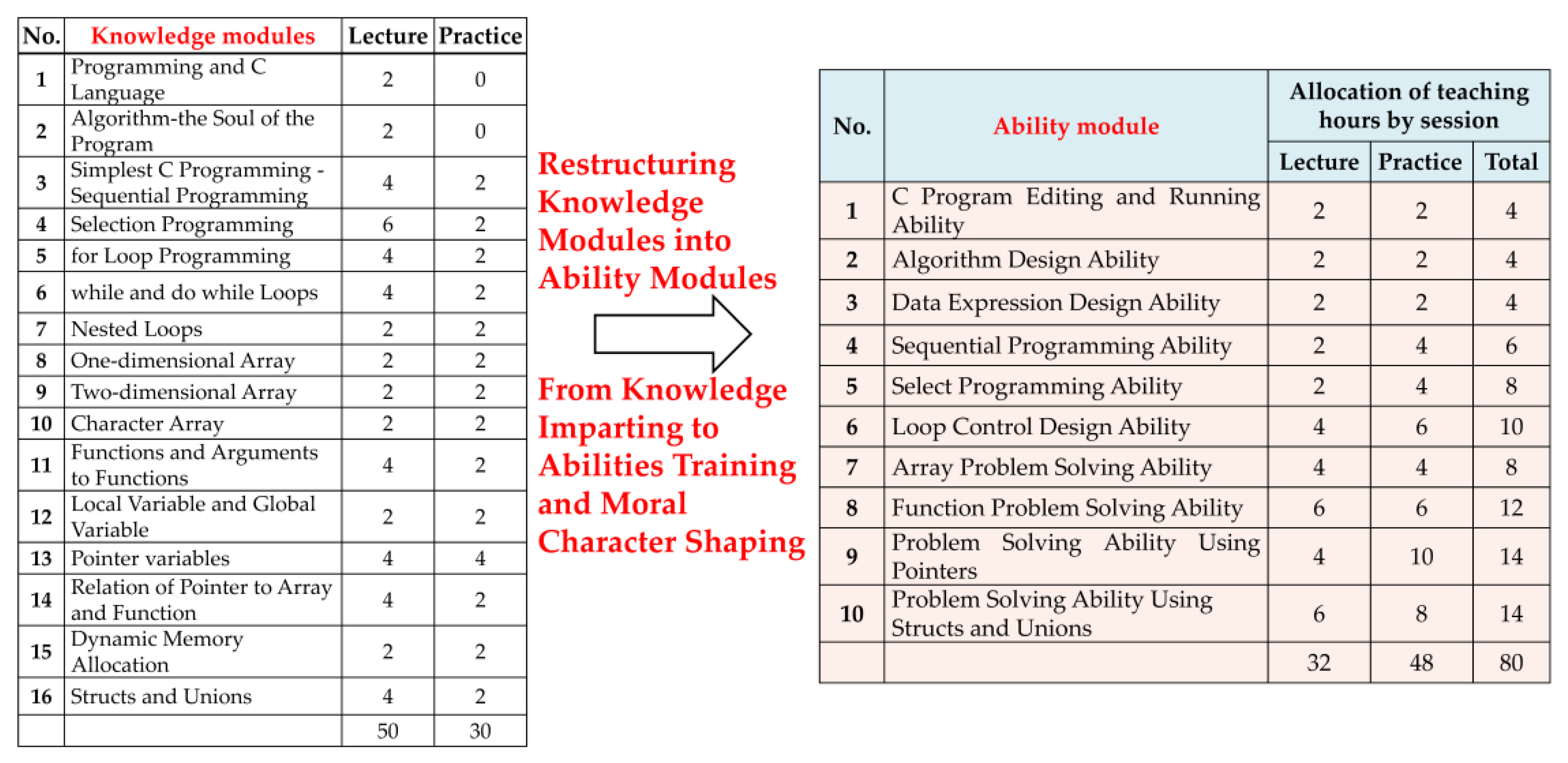
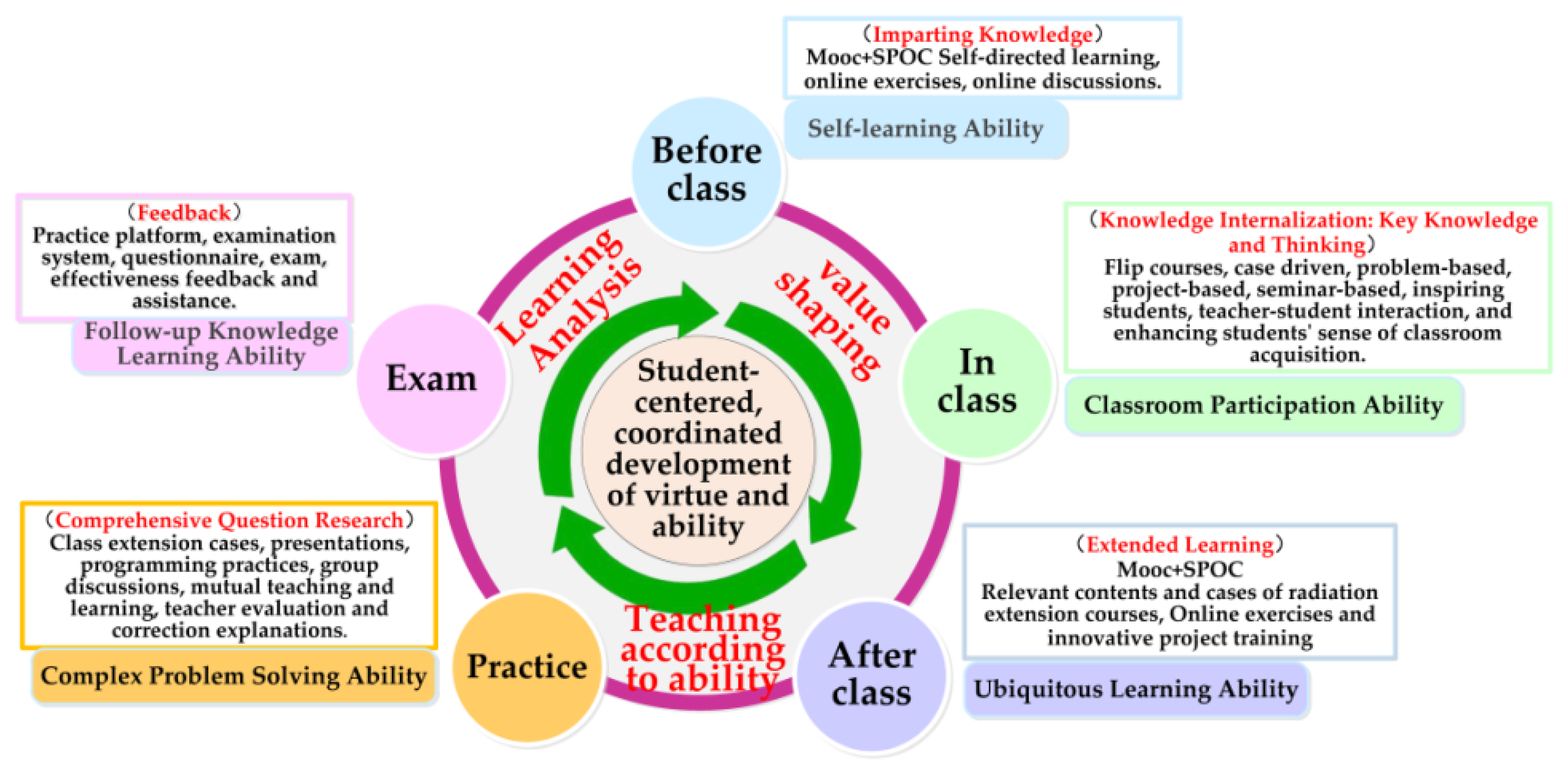
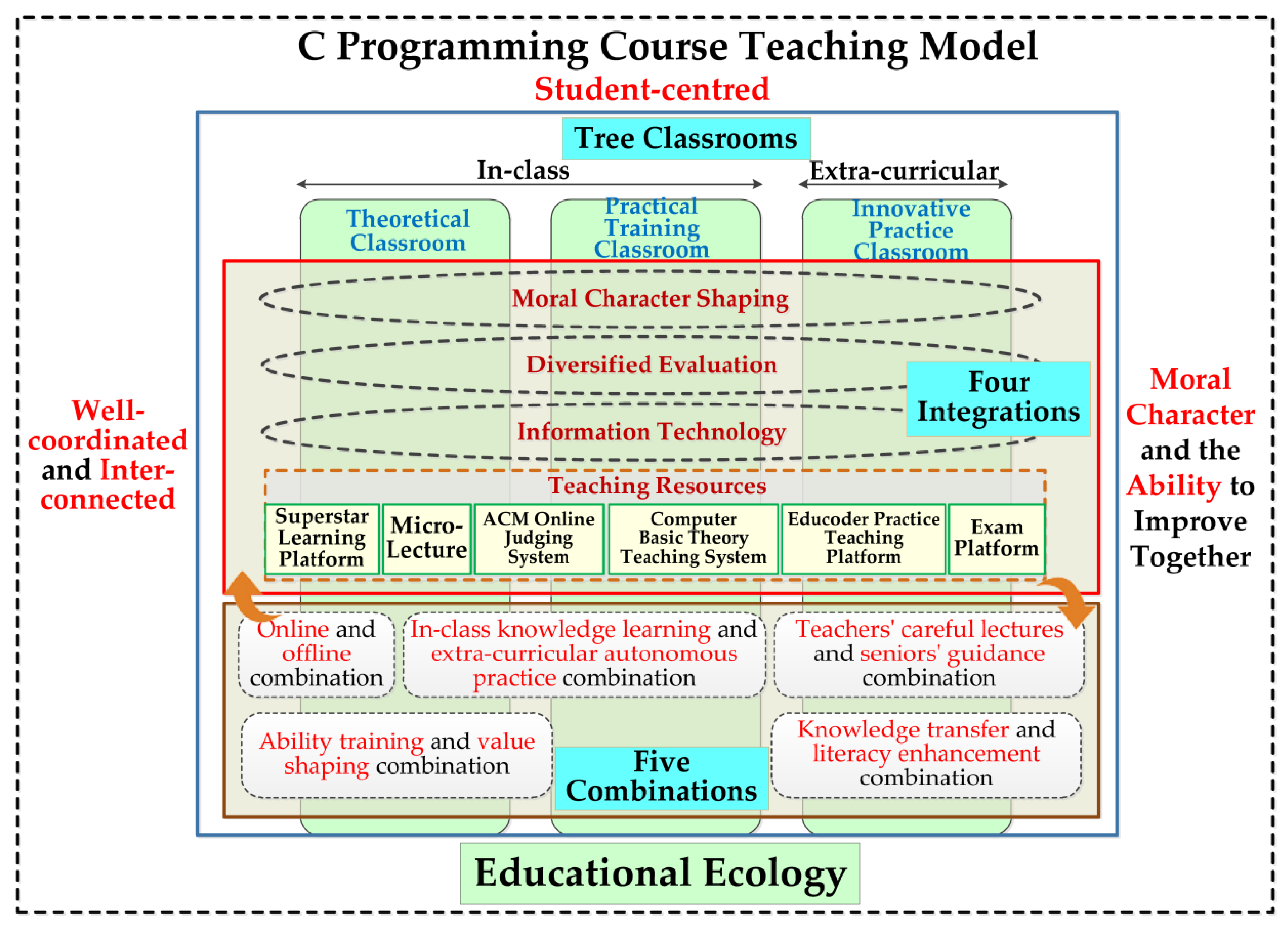
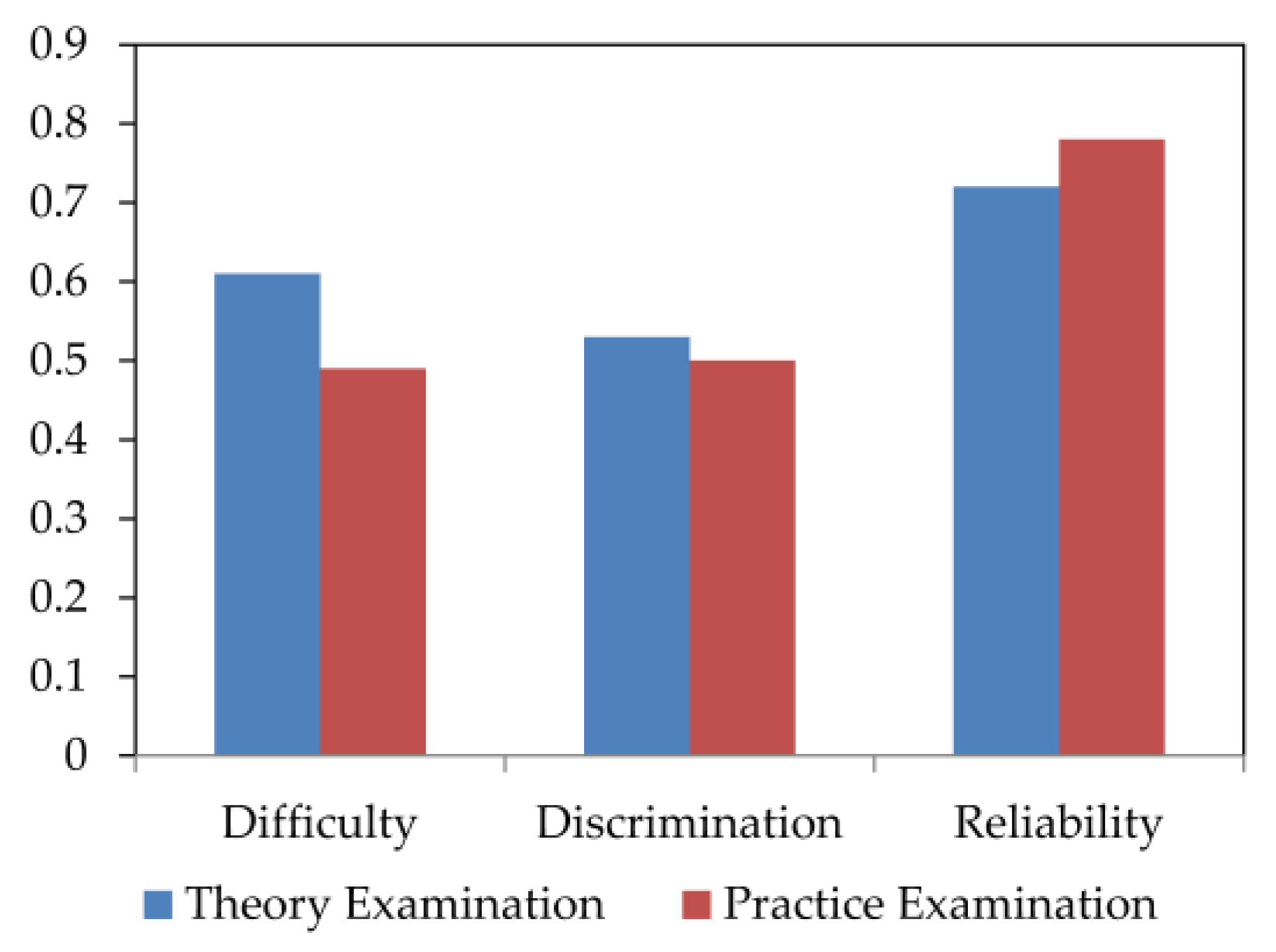
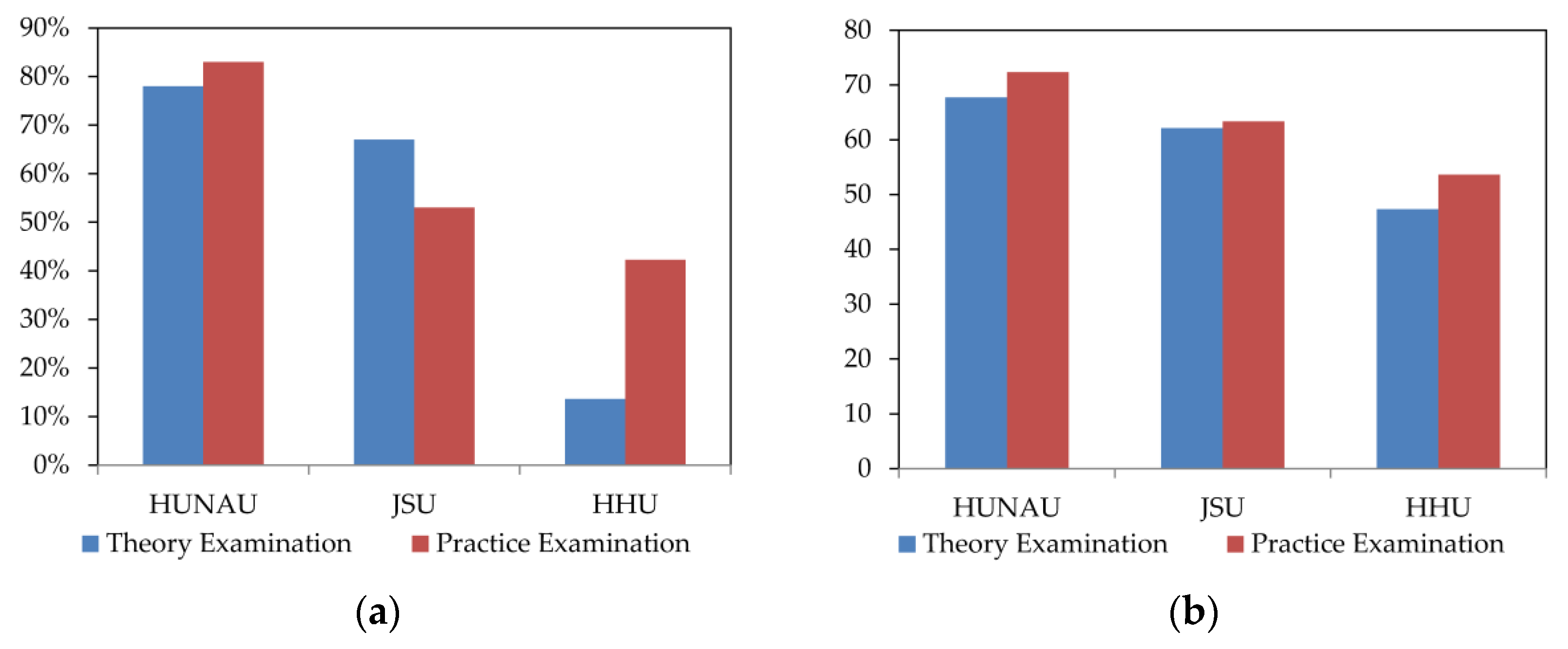
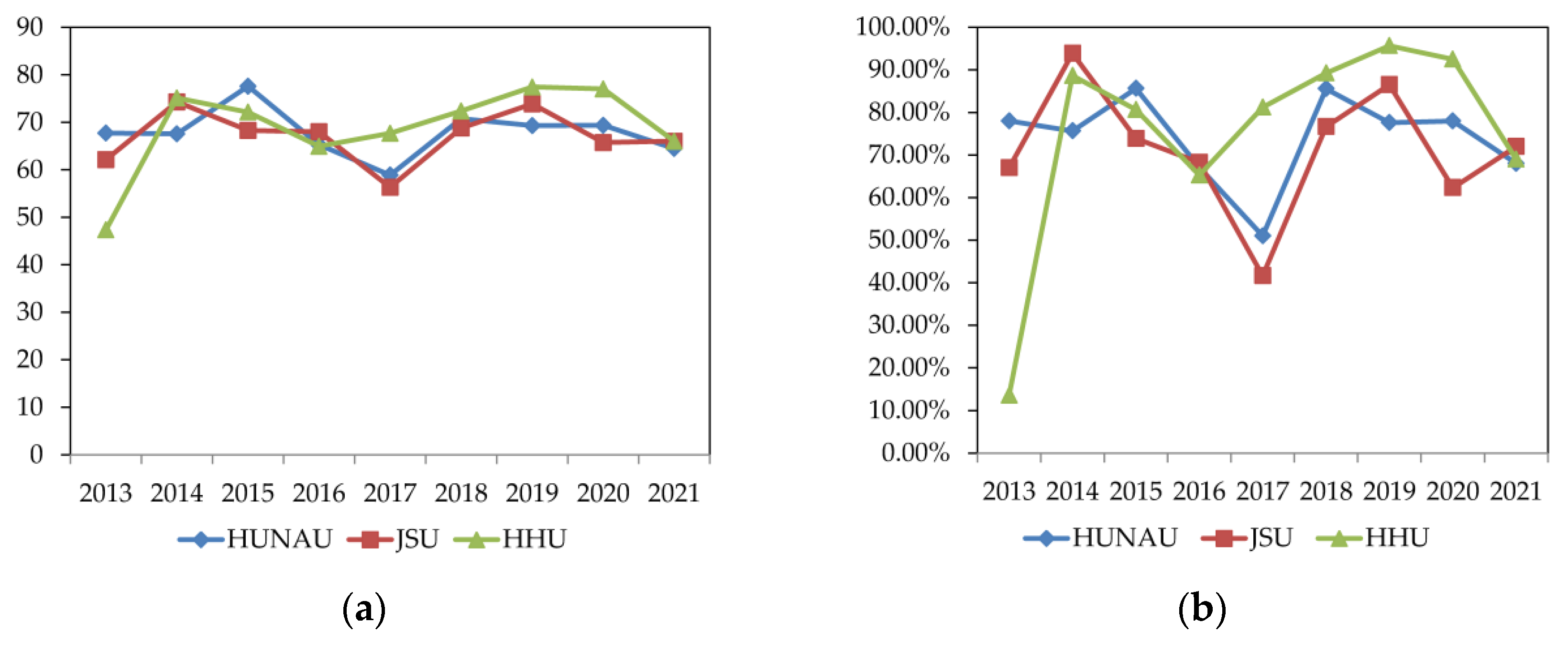

| Year | Number of Exam Participants | Difficulty | Discrimination | Reliability | |||
|---|---|---|---|---|---|---|---|
| Theory | Practice | Theory | Practice | Theory | Practice | ||
| 2013 | 816 | 0.612 | 0.491 | 0.532 | 0.501 | 0.721 | 0.782 |
| 2014 | 827 | 0.751 | 0.602 | 0.473 | 0.401 | 0.824 | 0.667 |
| 2015 | 862 | 0.666 | 0.639 | 0.425 | 0.615 | 0.685 | 0.701 |
| 2016 | 968 | 0.667 | 0.738 | 0.441 | 0.427 | 0.702 | 0.718 |
| 2017 | 963 | 0.608 | 0.660 | 0.491 | 0.417 | 0.715 | 0.705 |
| 2018 | 1075 | 0.706 | 0.617 | 0.441 | 0.614 | 0.792 | 0.727 |
| 2019 | 1158 | 0.729 | 0.559 | 0.468 | 0.526 | 0.856 | 0.801 |
| 2020 | 1217 | 0.702 | 0.678 | 0.526 | 0.623 | 0.849 | 0.823 |
| 2021 | 1452 | 0.472 | 0.537 | 0.643 | 0.702 | 0.784 | 0.814 |
| Year | 2018 | 2019 | 2020 | 2021 | ||||||||
|---|---|---|---|---|---|---|---|---|---|---|---|---|
| Course objective achievement degree | Obj1 | Obj2 | Obj3 | Obj1 | Obj2 | Obj3 | Obj1 | Obj2 | Obj3 | Obj1 | Obj2 | Obj3 |
| 0.791 | 0.625 | 0.809 | 0.784 | 0.620 | 0.714 | 0.756 | 0.803 | 0.768 | 0.757 | 0.645 | 0.781 | |
| Weights | 0.4 | 0.4 | 0.2 | 0.4 | 0.4 | 0.2 | 0.4 | 0.4 | 0.2 | 0.4 | 0.4 | 0.2 |
| Course achievement degree | 0.728 | 0.705 | 0.777 | 0.717 | ||||||||
| Award Level | Competition Name | First Prize | Second Prize | Third Prize |
|---|---|---|---|---|
| National level | China University Computer Competition National Finals—Group Programming Ladder Tournament | 1 | 3 | |
| Lan Qiao Cup Individual Competition (Software Category) National Final | 2 | 14 | 15 | |
| China Collegiate Programming Contest—National Invitational Contest | 2 | 1 | ||
| ACM-ICPC Asia Regional Programming Contest | 1 | 6 | ||
| Provincial level | China University Computer Competition Provincial Competition—Group Programming Ladder Tournament | 1 | 4 | 7 |
| Lan Qiao Cup Individual Competition (Software Category) Hunan Regional Competition | 38 | 76 | 92 | |
| Hunan Collegiate Programming Contest | 12 | 26 | ||
| CCF Collegiate Computer System & Programming Contest | 1 | 4 | ||
| China Collegiate Computing Contest—WeChat Small Program Application Development Competition | 1 | 1 | ||
| “Oracle Cup” National Java Programming Contest Middle South Division | 8 | 2 |
| No. | Course Name | Start Time | Lasting Years | Course Honor |
|---|---|---|---|---|
| 1 | Java Programming | 2015 | 8 | Hunan first-class course |
| 2 | HTML5 Application | 2017 | 6 | Hunan first-class course |
| 3 | Software Engineering | 2017 | 6 | Hunan first-class course |
| 4 | Computer networks | 2018 | 5 | Hunan first-class course |
| 5 | University Computer Fundamentals | 2018 | 5 | Hunan first-class course |
| 6 | Electronic Commerce | 2018 | 5 | Hunan first-class course |
| 7 | Data Structure | 2016 | 7 | School-level first-class course |
| 8 | Communication Electronic Circuit | 2017 | 6 | School-level first-class course |
| 9 | Fundamentals of Circuit Analysis | 2018 | 5 | School-level first-class course |
| 10 | Principles of Communication | 2018 | 5 | School-level first-class course |
| 11 | java web Application Development | 2019 | 4 | |
| 12 | Enterprise Application Development | 2019 | 4 |
Publisher’s Note: MDPI stays neutral with regard to jurisdictional claims in published maps and institutional affiliations. |
© 2022 by the authors. Licensee MDPI, Basel, Switzerland. This article is an open access article distributed under the terms and conditions of the Creative Commons Attribution (CC BY) license (https://creativecommons.org/licenses/by/4.0/).
Share and Cite
Yao, D.; Zhang, X.; Liu, Y. Teaching Reform in C Programming Course from the Perspective of Sustainable Development: Construction and 9-Year Practice of “Three Classrooms–Four Integrations–Five Combinations” Teaching Model. Sustainability 2022, 14, 15226. https://doi.org/10.3390/su142215226
Yao D, Zhang X, Liu Y. Teaching Reform in C Programming Course from the Perspective of Sustainable Development: Construction and 9-Year Practice of “Three Classrooms–Four Integrations–Five Combinations” Teaching Model. Sustainability. 2022; 14(22):15226. https://doi.org/10.3390/su142215226
Chicago/Turabian StyleYao, Dunhong, Xian Zhang, and Yiwen Liu. 2022. "Teaching Reform in C Programming Course from the Perspective of Sustainable Development: Construction and 9-Year Practice of “Three Classrooms–Four Integrations–Five Combinations” Teaching Model" Sustainability 14, no. 22: 15226. https://doi.org/10.3390/su142215226
APA StyleYao, D., Zhang, X., & Liu, Y. (2022). Teaching Reform in C Programming Course from the Perspective of Sustainable Development: Construction and 9-Year Practice of “Three Classrooms–Four Integrations–Five Combinations” Teaching Model. Sustainability, 14(22), 15226. https://doi.org/10.3390/su142215226






